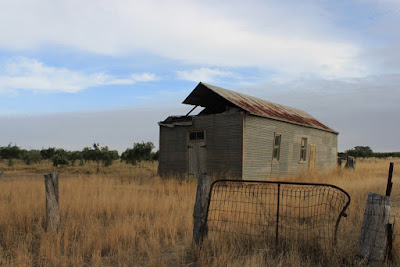On the outskirts of the Donald township, straddling its own railway track, are the rusting remains of the Donald Inland Freezing Company's buildings.
 |
| The layout of the freezing works |
The works cover 10 acres of 109 acres of company owned land of resting paddocks. Most of the buildings are abandoned or converted to other uses. Only the portion of the rail-line to the grain silos is utilised.
 |
| A grain train loading at the silos |
Built at a cost £130,000 by the Donald Inland Freezing Company, it started in 1920 (the foundation stone was laid on August 31 1920 by the Victorian Premier Sir Harry Lawson).
It was registered as a shareholders company in September 1919, with an opening capital of £100,000. In 1920, the state government gave loans to both the Donald and Murtoa freezing works for extensions. The plant was erected under the Primary Products Advance Act. Preference was to be given to the employment of Returned Servicemen.
 |
| The slaughterhouse and toppled chimney |
The plant had a killing capacity of 2,500 lambs by a full board of 28 butchers per day, with storage for 60,000 carcasses.
 |
| The sheepyards with the ramp to the slaughter house |
The skins and offal gravitated down chutes to the ground floor. The dressed carcasses were conveyored by endless iron rail to the scales then to the hanging room, where they cooled for 4 hours then gravitated into an air-lock at the entrance to the 6 freezing chambers (each holding 1,200 carcasses). From 45 degrees Fahrenheit on the first day, the temperature was gradually reduced to 5 degrees on the third day. Carcasses then passed down through trapdoors into the 50,000 carcass storage chamber where they were stacked for transport.
 |
| Pieces of one of the engines |
The 70 square-foot Engine room supplied power generated by 3 sets of Hornsby 116 horse-power twin-cylinder gas engines, and the freezing was produced by two 60-ton Linde refrigerators powered by a 75 kilowatt electric generator.
Other buildings were the huge skin-drying shed, the tallow building for extraction and refinement of the fat.
The lamb was sold to a firm of London importers.
Ice was produced as a sideline and shipped as far north as Mildura, while the blood, offal and bones were converted into manure for the Mildura citrus growers.
 |
| The engine rooms |
Operations began in October 1921, but by 1922 the company was unable to make its repayments to the government and sought to increase the number of shareholders. In the 1922-23 season it slaughtered 96,000 lambs and sheep for the London markets, it was hampered by a shortage of slaughter-men. The shareholders agreed to joining the formation of Amalgamated Freezing Companies (it later became the Inland Meat Authority) in March 1927. This was followed by a Royal Commission into AFC in August, and the Company was again in arrears to the government in October.
 |
| The rail-line & slaughterhouse (the brown ceramic tiles on the walls cover a deep hollow block filled with cork) |
The works limped on, re-opening in September 1932 after being closed for several years, and by 1943 had only operated 4 times in the last 15 years, due to insufficient lamb supplies.
The plant closed and re-opened & closed again in 1977-78. The freezing section was turned into a yabby (freshwater crayfish) production plant 'Oz Crays' during the 1980s (now derelict). Oz Crays exported crayfish to France, the building has also been used for cultivating mushrooms.
 |
| The sign still advertising Oz Crays |
The north-most section is home to 'Kooka's Country Cookies' (established in 1990s). Cooka's nearly closed in 2012, but has since begun exporting to Asia, and can be seen on supermarket shelves and as individually wrapped biscuits in motels.


































